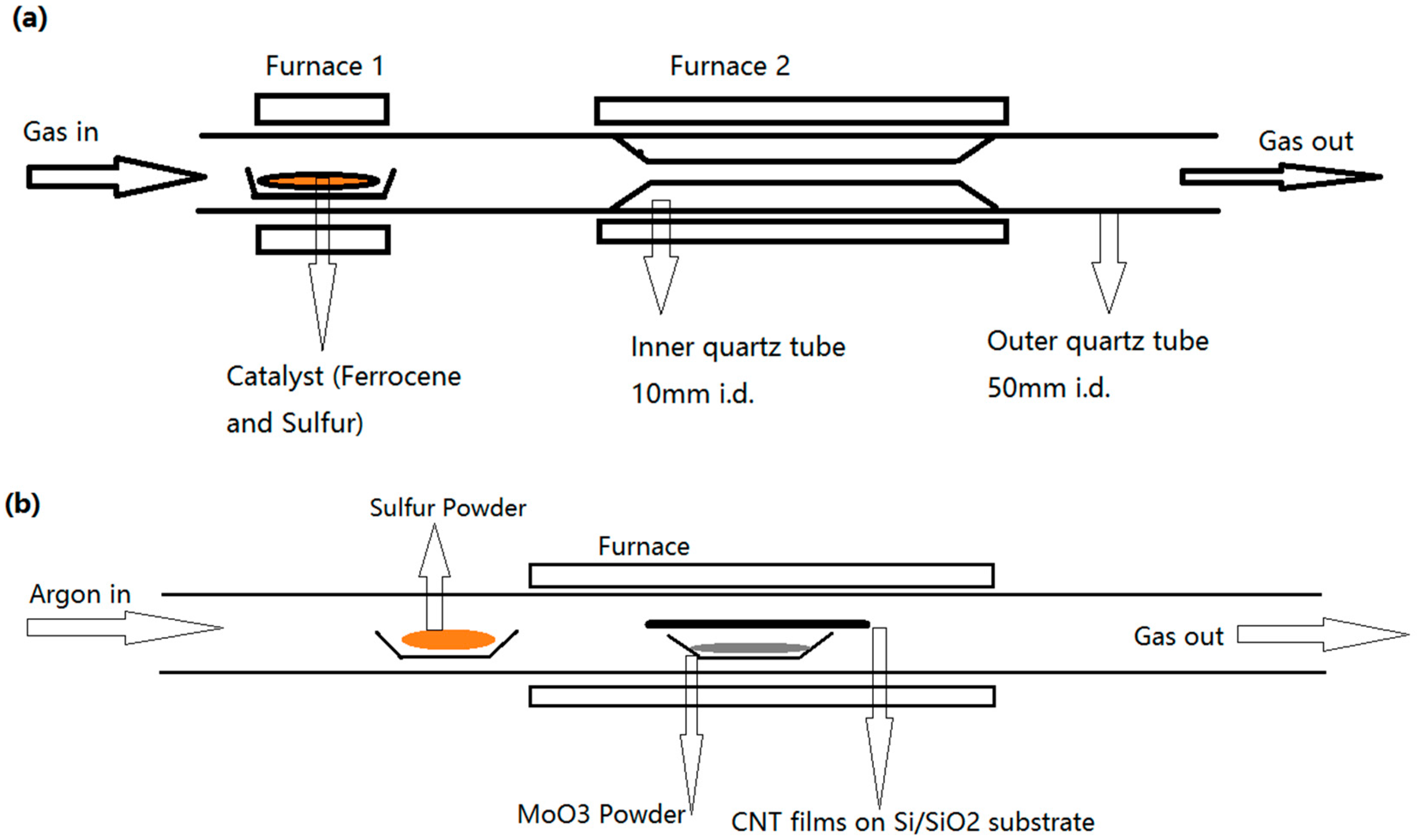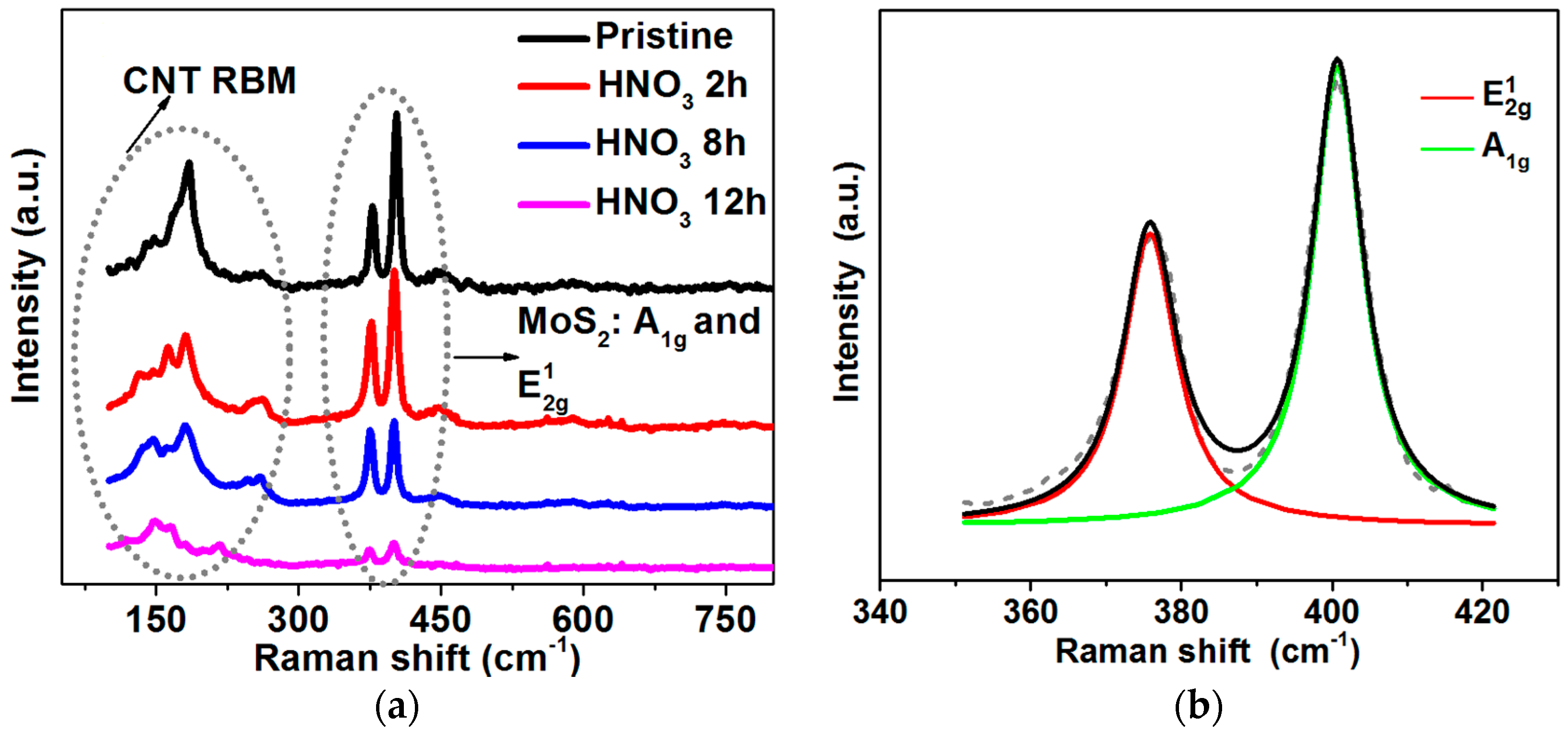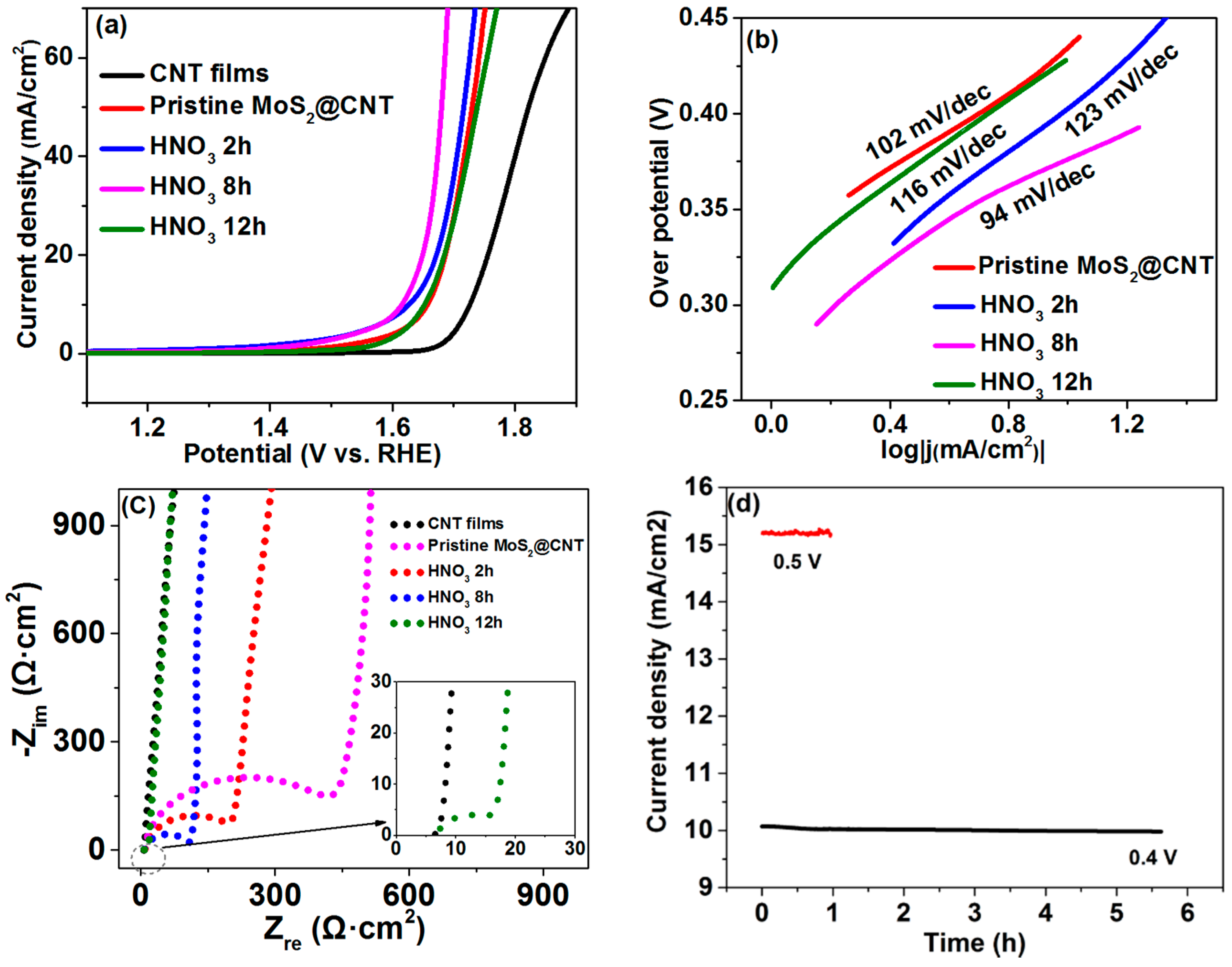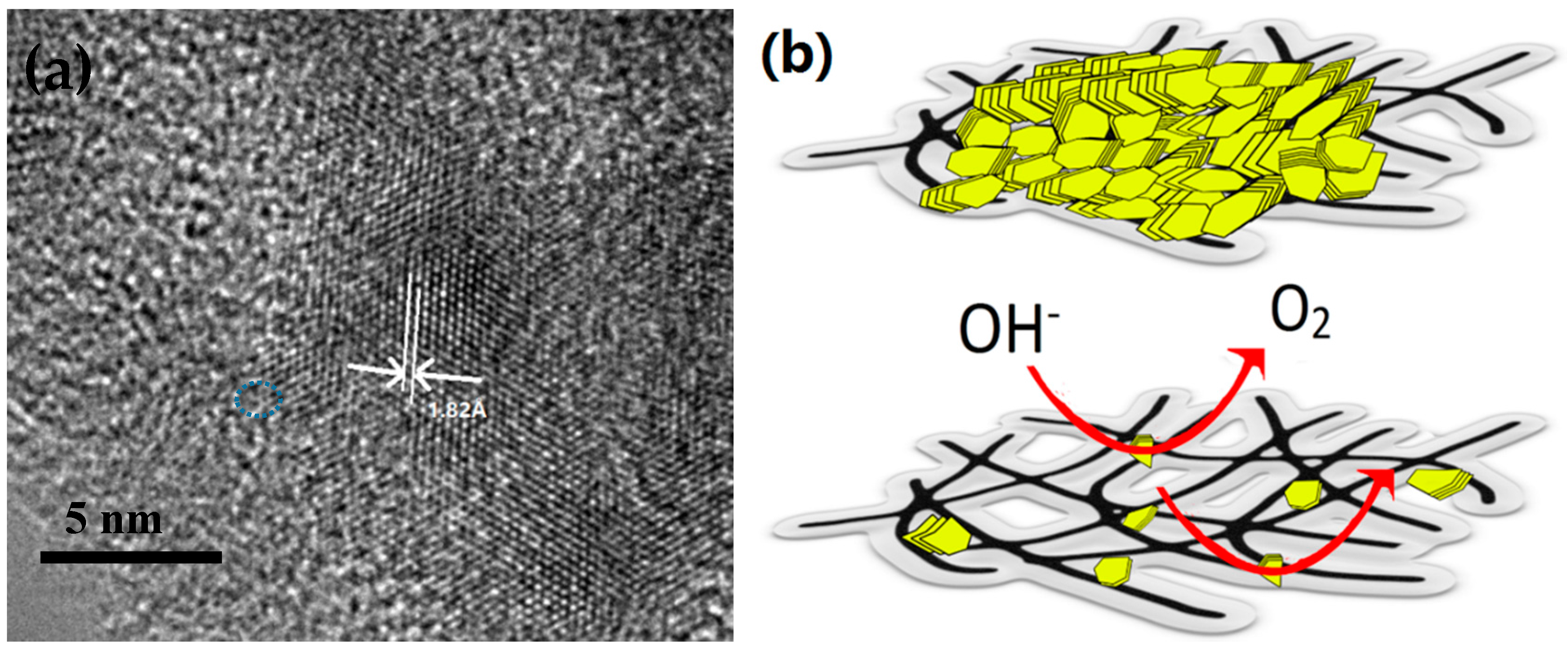Growing and Etching MoS2 on Carbon Nanotube Film for Enhanced Electrochemical Performance
Abstract
:1. Introduction
2. Results
2.1. Synthesis and Characterization of MoS2@CNT Composite
2.2. Electrochemical Performance Test of MoS2@CNT Composite
3. Discussion
4. Materials and Methods
4.1. Synthesis of CNT Film
4.2. Synthesis of MoS2@CNT
4.3. Characterizations
4.4. Electrochemical Measurements
5. Conclusions
Supplementary Materials
Acknowledgments
Author Contributions
Conflicts of Interest
References
- Green, M.A.; Emery, K.; Hishikawa, Y.; Warta, W.; Dunlop, E.D. Solar cell efficiency tables (Version 45). Prog. Photovolt. Res. Appl. 2015, 23. [Google Scholar] [CrossRef]
- Lenert, A.; Wang, E.N. Optimization of nanofluid volumetric receivers for solar thermal energy conversion. Sol. Energy 2012, 86, 253–265. [Google Scholar]
- Mei, A.; Li, X.; Liu, L.; Ku, Z.; Liu, T.; Rong, Y.G.; Xu, M.; Chen, J.Z.; Yang, Y. A hole-conductor-free, fully printable mesoscopic perovskite solar cell with high stability. Science 2014, 345, 295–298. [Google Scholar] [CrossRef] [PubMed]
- You, J.; Dou, L.; Yoshimura, K.; Kato, T.; Ohya, K.; Moriarty, T.; Emery, K.; Chen, C.C.; Gao, J.; Li, G.; et al. A polymer tandem solar cell with 10.6% power conversion efficiency. Nat. Commun. 2013, 4. [Google Scholar] [CrossRef] [PubMed]
- Díaz-González, F.; Sumper, A.; Gomis-Bellmunt, O.; Villafáfila-Robles, R. A review of energy storage technologies for wind power applications. Renew. Sustain. Energy Rev. 2012, 16, 2154–2171. [Google Scholar] [CrossRef]
- Hirth, L. The market value of variable renewables. Energy Econ. 2013, 38, 218–236. [Google Scholar] [CrossRef]
- Zhao, H.; Wu, Q.; Hu, S.; Xu, H.; Rasmussen, C.N. Review of energy storage system for wind power integration support. Appl. Energy 2015, 137, 545–553. [Google Scholar] [CrossRef]
- Follett, R.F.; Vogel, K.P.; Varvel, G.E.; Mitchell, R.B.; Kimble, J. Soil Carbon Sequestration by Switchgrass and No-Till Maize Grown for Bioenergy. BioEnergy Res. 2012, 5, 866–875. [Google Scholar] [CrossRef]
- Gelfand, I.; Saphajpal, R.; Zhang, X.; Izaurralde, R.C.; Fross, K.L.; Robertson, G.P. Sustainable bioenergy production from marginal lands in the US Midwest. Nature 2013, 493, 514–517. [Google Scholar] [CrossRef] [PubMed]
- Jones, C.S.; Mayfield, S.P. Algae biofuels: Versatility for the future of bioenergy. Curr. Opin. Biotechnol. 2012, 23, 346–351. [Google Scholar] [CrossRef] [PubMed]
- Meier, D.; Beld, D.V.B.; Bridgwater, A.V.; Elliott, D.C.; Oasmaa, A.; Preto, F. State-of-the-art of fast pyrolysis in IEA bioenergy member countries. Renew. Sustain. Energy Rev. 2013, 20, 619–641. [Google Scholar] [CrossRef]
- Mullet, J.; Morishige, D.; McCormick, R.; Truong, S.; Hilley, H.; McKinley, B.; Anderson, R.; Olson, S.; Rooney, W. Energy sorghum—A genetic model for the design of C4 grass bioenergy crops. J. Exp. Bot. 2014, 65, 3479–3489. [Google Scholar] [CrossRef] [PubMed]
- Greeley, J.; Markovic, N.M. The road from animal electricity to green energy: Combining experiment and theory in electrocatalysis. Energy Environ. Sci. 2012, 5. [Google Scholar] [CrossRef]
- Diaz-Morales, O.; Ledezma-Yanez, I.; Koper, M.T.M.; Calle-Vallejo, F. Guidelines for the Rational Design of Ni-Based Double Hydroxide Electrocatalysts for the Oxygen Evolution Reaction. ACS Catalysis 2015, 5, 5380–5387. [Google Scholar] [CrossRef]
- Buscema, M.; Barkelid, M.; Zwiller, V.; Zant, H.S.; Steele, G.A.; Castellanos-Gomez, A. Large and tunable photothermoelectric effect in single-layer MoS2. Nano Lett. 2013, 13, 358–363. [Google Scholar] [CrossRef] [PubMed]
- Castellanos-Gomez, A.; Cappelluti, E.; Roldán, R.; Agrait, N.; Guinea, F.; Rubio-Bollinger, G. Electric-field screening in atomically thin layers of MoS2: The role of interlayer coupling. Adv. Mater. 2013, 25, 899–903. [Google Scholar] [CrossRef] [PubMed]
- Chuang, S.; Battaglia, C.; Azcatl, A.; McDonnell, S.; Kang, J.S.; Yin, X.; Tosun, M.; Kapadia, R.; Fang, H.; Mallace, R.M.; et al. MoS2 P-type transistors and diodes enabled by high work function MoOx contacts. Nano Lett. 2014, 14, 1337–1342. [Google Scholar] [CrossRef] [PubMed]
- Chen, Z.; Cummins, D.; Reinecke, B.N.; Clark, E.; Sunkara, M.K.; Jaramillo, T.F. Core-shell MoO3-MoS2 nanowires for hydrogen evolution: A functional design for electrocatalytic materials. Nano Lett. 2011, 11, 4168–4175. [Google Scholar] [CrossRef] [PubMed]
- Drescher, T.; Niefind, F.; Bensch, W.; Grunert, W. Sulfide catalysis without coordinatively unsaturated sites: Hydrogenation, cis-trans isomerization, and H2/D2 scrambling over MoS2 and WS2. J. Am. Chem. Soc. 2012, 134, 18896–18899. [Google Scholar] [CrossRef] [PubMed]
- Bindumadhavan, K.; Srivastava, S.K.; Mahanty, S. MoS2-MWCNT hybrids as a superior anode in lithium-ion batteries. Chem. Commun. 2013, 49, 1823–1825. [Google Scholar] [CrossRef] [PubMed]
- Chang, K.; Chen, W. In situ synthesis of MoS2/graphene nanosheet composites with extraordinarily high electrochemical performance for lithium ion batteries. Chem Commun. 2011, 47, 4252–4254. [Google Scholar] [CrossRef] [PubMed]
- Chang, K.; Geng, D.; Li, X.; Yang, J.; Tang, Y.; Cai, M.; Li, R.; Sun, X. Ultrathin MoS2/Nitrogen-Doped Graphene Nanosheets with Highly Reversible Lithium Storage. Adv. Energy Mater. 2013, 3, 839–844. [Google Scholar] [CrossRef]
- Li, Y.; Wang, H.; Xie, L.; Liang, Y.; Hong, G.; Dai, H. MoS2 nanoparticles grown on graphene: An advanced catalyst for the hydrogen evolution reaction. J. Am. Chem. Soc. 2011, 133, 7296–7299. [Google Scholar] [CrossRef] [PubMed]
- Yan, K.; Lu, Y. Direct Growth of MoS2 Microspheres on Ni Foam as a Hybrid Nanocomposite Efficient for Oxygen Evolution Reaction. Small 2016, 12, 2975–2981. [Google Scholar] [CrossRef] [PubMed]
- Hu, S.; Chen, W.; Zhou, J.; Yin, F.; Uchaker, E.; Zhang, Q.; Cao, G. Preparation of carbon coated MoS2 flower-like nanostructure with self-assembled nanosheets as high-performance lithium-ion battery anodes. J. Mater. Chem. A 2014, 2. [Google Scholar] [CrossRef]
- Voiry, D.; Salehi, M.; Silva, R.; Fujita, T.; Chen, M.; Asefa, T.; Shenoy, V.B.; Eda, G.; Chhowalla, M. Conducting MoS2 nanosheets as catalysts for hydrogen evolution reaction. Nano Lett. 2013, 13, 6222–6227. [Google Scholar] [CrossRef] [PubMed]
- Tian, Y.; Zhao, J.; Fu, W.; Liu, Y.; Zhu, Y.; Wang, Z. A facile route to synthesis of MoS2 nanorods. Mater. Lett. 2005, 59, 3452–3455. [Google Scholar] [CrossRef]
- Liu, D.; Xu, W.; Liu, Q.; He, Q.; Haleem, Y.A.; Xiang, T.; Zou, C.; Chu, W.; Zhong, J.; Niu, Z.; et al. Unsaturated-sulfur-rich MoS2 nanosheets decorated on free-standing SWNT film: Synthesis, characterization and electrocatalytic application. Nano Res. 2016, 9, 2079–2087. [Google Scholar] [CrossRef]
- Shi, Y.; Li, H.; Li, L.J. Recent advances in controlled synthesis of two-dimensional transition metal dichalcogenides via vapour deposition techniques. Chem. Soc. Rev. 2015, 44, 2744–2756. [Google Scholar] [CrossRef] [PubMed]
- Song, L.; Ci, L.; Lv, L.; Zhou, Z.; Yan, X.; Liu, D.; Yuan, H.; Gao, Y.; Wang, J.; Liu, L. Direct synthesis of a macroscale single-walled carbon nanotube non-woven material. Adv. Mater. 2004, 16. [Google Scholar] [CrossRef]
- Li, H.; Zhang, Q.; Yap, C.C.; Tay, B.K.; Edwin, T.H.; Olivier, A.; Baillargeat, D. From Bulk to Monolayer MoS2: Evolution of Raman Scattering. Adv. Funct. Mater. 2012, 22, 1385–1390. [Google Scholar] [CrossRef]
- Burrow, B.J. A correlation of Auger electron spectroscopy, X-ray photoelectron spectroscopy, and Rutherford backscattering spectrometry measurements on sputter-deposited titanium nitride thin films. J. Vac. Sci. Technol. A 1986, 4. [Google Scholar] [CrossRef]
- Amara, K.K.; Chu, L.; Kumar, R.; Toh, M.; Eda, G. Wet chemical thinning of molybdenum disulfide down to its monolayer. APL Mater. 2014, 2. [Google Scholar] [CrossRef]
- Shariza, S.; Anand, T.J.S. Effect of Deposition Time on the Structural and Optical Properties of Molybdenum Chalcogenides Thin Films. Chalcogenide Lett. 2011, 8, 529–539. [Google Scholar]
- Sample Availability: Samples of the compounds are available from the authors.






| Atomic Ratio | Pristine | 10% wt HNO3 2 h | 10% wt HNO3 8 h | 10% wt HNO3 12 h |
|---|---|---|---|---|
| Surface Mo and C atomic ratio | 1.555 | 0.073 | 0.047 | 0.009 |
© 2016 by the authors. Licensee MDPI, Basel, Switzerland. This article is an open access article distributed under the terms and conditions of the Creative Commons Attribution (CC-BY) license ( http://creativecommons.org/licenses/by/4.0/).
Share and Cite
Xu, W.; Fang, Q.; Liu, D.; Zhang, K.; Habib, M.; Wu, C.; Zheng, X.; Liu, H.; Chen, S.; Song, L. Growing and Etching MoS2 on Carbon Nanotube Film for Enhanced Electrochemical Performance. Molecules 2016, 21, 1318. https://doi.org/10.3390/molecules21101318
Xu W, Fang Q, Liu D, Zhang K, Habib M, Wu C, Zheng X, Liu H, Chen S, Song L. Growing and Etching MoS2 on Carbon Nanotube Film for Enhanced Electrochemical Performance. Molecules. 2016; 21(10):1318. https://doi.org/10.3390/molecules21101318
Chicago/Turabian StyleXu, Weiyu, Qi Fang, Daobin Liu, Ke Zhang, Muhammad Habib, Chuanqiang Wu, Xusheng Zheng, Hengjie Liu, Shuangming Chen, and Li Song. 2016. "Growing and Etching MoS2 on Carbon Nanotube Film for Enhanced Electrochemical Performance" Molecules 21, no. 10: 1318. https://doi.org/10.3390/molecules21101318
APA StyleXu, W., Fang, Q., Liu, D., Zhang, K., Habib, M., Wu, C., Zheng, X., Liu, H., Chen, S., & Song, L. (2016). Growing and Etching MoS2 on Carbon Nanotube Film for Enhanced Electrochemical Performance. Molecules, 21(10), 1318. https://doi.org/10.3390/molecules21101318






